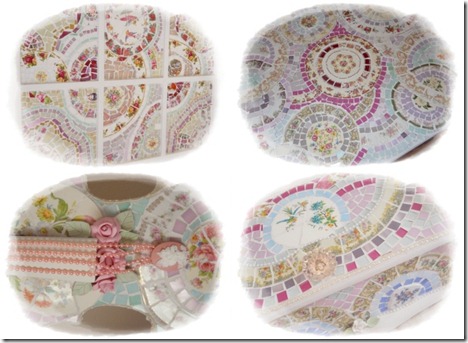Departments
Search
Follow Us
Tags
Latest Highlights
IBH
Let’s talk about Pique Assiette Mosaic
Pique Assiette is a form of Mosaic originating in France. Since I am into that sort of Art Mosaic I thought I will talk about it a bit. My Mosaic Art is all about pique assiette.
Pique Assiette, French (pikasjɛt) is a form of art similar to most mosaic but specifically uses broken plates and the like arranged in patterns or designs.
 It has been refined by many mosaic artists these days, by somehow using a Tile Nipper or even Tile Saw for precise cuts and beautiful laid out patterns by using just the plate rims only,cutting away the “footer”, which is the thicker rim underneath the plate on which the plate stands, that is basically useless. Most of these pique assiette pieces are enhanced with stained glass pieces, and finished up with jewelry, and other pretties and baubles.
It has been refined by many mosaic artists these days, by somehow using a Tile Nipper or even Tile Saw for precise cuts and beautiful laid out patterns by using just the plate rims only,cutting away the “footer”, which is the thicker rim underneath the plate on which the plate stands, that is basically useless. Most of these pique assiette pieces are enhanced with stained glass pieces, and finished up with jewelry, and other pretties and baubles.
The name comes from the French Pique-Assiette, meaning “one who eats from others’ plates, or one who steals other plates”. This is a very loosely used translation of the French words. faceb Pique Assiette is a style of mosaic that incorporates pieces of broken ceramics—plates, dishes, cups, tiles — and other found objects into the design. The appeal and expressiveness of pique assiette lies in the ideas of lateral thinking, humor, recycling, and the significance of the found objects. I only use already damaged china plates (rims and focal centers), which have flea bites, scratches, cracks and have become useless for a regular household. Thereby I am recycling and give a vintage substrate new life in another form.
This form of art is believed to have been originally introduced by Raymond Edouard Isadore, known as the “father of French pique assiette”. He discovered his bits of colored glass and pottery in the fields surrounding his house in Chartres, outside of Paris, and spent his life covering every surface of the inside and outside of the house and his garden area. He supplemented his shards with stuff from auctions, quarries and the public dump. His home is a popular tourist attraction and is known as “Maison Picassiette”.
 La Maison Picassiette is the extraordinary result of one man’s work between 1938 and 1964. The monument he left behind is a house and garden covered with intricate mosaics of broken crockery, painting and sculpture. Much has been written to try to explain why Raymonde Isidore, a middle-aged manual worker, produced such a beautiful, complicated, inspirational and mystifying environment from the house he had built for his family. Perhaps what is amazing is not just that he chose to devote himself to his project, but that he achieved so much. The scale and richness is awe-inspiring.
La Maison Picassiette is the extraordinary result of one man’s work between 1938 and 1964. The monument he left behind is a house and garden covered with intricate mosaics of broken crockery, painting and sculpture. Much has been written to try to explain why Raymonde Isidore, a middle-aged manual worker, produced such a beautiful, complicated, inspirational and mystifying environment from the house he had built for his family. Perhaps what is amazing is not just that he chose to devote himself to his project, but that he achieved so much. The scale and richness is awe-inspiring.
In France La Maison Picassiette is set back from a modern urban street not far from the center of Chartres (50 miles – southwest of Paris). You reach it by walking down a narrow footpath. A small ticket booth and traditional French toilets have been added outside the front courtyard of the house. 30,000 visitors a year come to this place of wonder. The house is very modest in size, and is long and thin in shape, matching the dimensions of the plot it stands on. The doors and windows are all on the right hand side, facing south. All the rage in the 1920s, the art of pique assiette is now back in vogue all over the world. Each project can be accomplished in only 4 steps! Find a substrate, cutting, gluing, grouting and sealing. From furniture pieces to accessories and gifts to murals and art, these pique assiette pieces will be admired by high-end collectors and flea-market aficionados alike.
Submitted by Monika of Myeropeantouch
Tags: Handmade, Handmade Artists, handmade mosaic, mosaic styles, pique assiette mosaic
Posted in Creative Breakroom
3 Responses to “Let’s talk about Pique Assiette Mosaic”
Leave a Reply
You must be logged in to post a comment.


Oh Monika I love it! I knew what Pique Assiette means but never knew about Isadore! Oh my, could you imagine doing a whole house?? I would love to be able to see it in person.
Hey, lets go, off to Paris……LOL
I had to do a little exploring, each site has pretty much the same pictures, but also something different. Some jaw dropping mosaic work!
http://www.thejoyofshards.co.uk/picassiette/index.shtml#anchor184676
http://curious-places.blogspot.com/2011/01/la-maison-picassiette-chartres-france.html
http://www.discover-chartres.com/maison-picassiette.html
http://www.art-insolite.com/pageinsolites/insopicassiette.htm
http://www.dailymotion.com/video/x7brtq_mosaic-maison-chartres-france_travel#.UePweG3gers